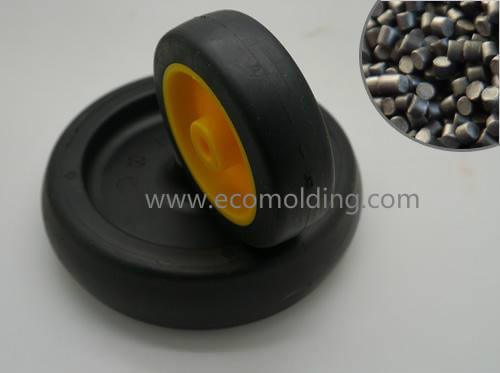Thermoplastic Elastomer (TPE)

Domestically in China, it is usually known as “TPE”, basically referring to the styrene-based thermoplastic elastomer.
The styrene-based TPE (known as TPS in foreign markets) is a copolymer of butadiene or isoprene and styrene block, so its performance is similar to that of SBR.
Strengths: High elasticity of rubber and plastic injection moldability; environmentally friendly, non-toxic and safe; excellent coloring, smooth touch, weatherability, fatigue / temperature resistance, excellent processability, no need for vulcanization, and able to be recycled for cost reduction. It can be co-molded with such base materials as PP, PE, PC, PS and ABS, or molded separately.
Weaknesses: The biggest problem with SBS and SIS is their low heat resistance – the temperature should not exceed 80°C. At the same time, its strength, weatherability, oil / wear resistance, etc. are also incomparable to those of rubber.
Styrene-based TPR: Thermoplastic Rubber
TPR was originally named by the Americans. Back then, there was no uniformed nomenclature for thermoplastic elastomers. It was customary to use the English acronym TPR for thermoplastic rubbers, and TPE for thermoplastic elastomers (both are used in related articles), which was applied to the simple blends of PP and EPDM. Later, the PP/EPDM-based TPV (originally referred to as TPR, and later renamed as TPV) of AES also followed this nomenclature. After that, it became popular among the Taiwanese, as well as in mainland China. Regardless of the foreign names, the TPR and styrene-based TPE currently mean the same thing in China, indicating that it is a thermoplastic styrene-butadiene-styrene copolymer, which is commonly known as thermoplastic styrene-butadiene rubber, i.e., in China, TPE = styrene-based TPE.
However, due to historical and translation issues, the Chinese name for TPV (thermoplastic vulcanizate) is referred to as thermoplastic rubber, i.e., TPR. That is why we don’t tell our customers that our PP/EPDM-based TPV is referred to as TPR, because some customers take it for the styrene-based elastomer. If it is an SBS-based material, the price would be much lower than that of TPV.
Thermoplastic Polyurethane (AKA TPU)
The polyurethane-based TPE is a thermoplastic polyurethane rubber formed by block-bonding the hard segment of the isocyanate-reacted urethane and the soft segment of the polyester or polyether, abbreviated as TPU.
Strengths: TPU boasts an excellent mechanical strength, as well as resistance to wear, oil and flex. Especially, its wear resistance is the most outstanding; temperature resistance: -30-120°C.
Weaknesses: Poor resistance to heat, hot water and compression; prone to yellow discoloration, and mold sticking; requiring high precision processing, leading to a higher cost.
At present, wherever PVC is used, TPU can always be a substitute for it. However, in terms of the strengths of TPU, PVC is far behind. Its hardness ranges from 65A to 85D. The colors are natural, transparent, or highly translucent. TPU not only features excellent tension, tensile strength, toughness and aging resistance, but is also a mature environmentally-friendly material. At present, TPU is widely used in: shoe materials, ready-to-wear, inflatable toys, equipment for water / underwater sports, medical equipment, fitness equipment, car seat materials, umbrellas, luggage, and leather bags, etc.
TPV – Thermoplastic Vulcanizate
Dynamic vulcanization refers to the chemical cross-linking of the rubber phase under the action of the cross-linking agent when the thermoplastic resin is melt-blended with the rubber, and is sheared and broken into a large number of micro-sized and crosslinked rubber particles by a strong mechanical shearing action, which are then dispersed in a continuous phase of the thermoplastic resin.
Taking PP as the hard segment and EPDM as the soft segment for melt blending, a cross-linking agent for vulcanization is added during the melt blending process. The high shearing force of such machines as an internal mixer or a screw machine, is leveraged to disperse the fully vulcanized and crosslinked EPDM rubber particles into the PP matrix in micron size (less than 1 micron).
- TPV possesses the heat resistance and low-compression deformation properties of the vulcanized rubber;
- Excellent processability: It can be processed by injection molding, extrusion and other thermoplastic processing methods. It is efficient, simple and easy to operate, and requiring no extra equipment, with a high fluidity and small shrinkage.
- Low relative density (0.90-0.97), uniform appearance, high surface quality and smooth touch.
- Usually, TPV can be used at the temperatures from -60°C to +135°C; when not subjected to load, it is able to withstand the high temperature of up to +150°C.
- A wide range of hardness, 25A-70D;
- TPV boasts excellent acid and alkali resistance, and is strongly resistant to acid-based detergents. It is able to maintain its original characteristics after long-term application in acidic environment.
